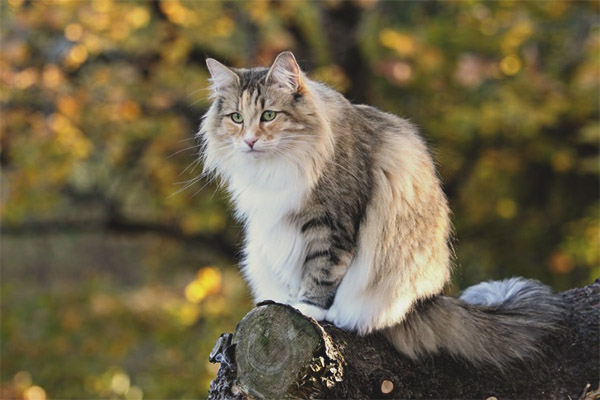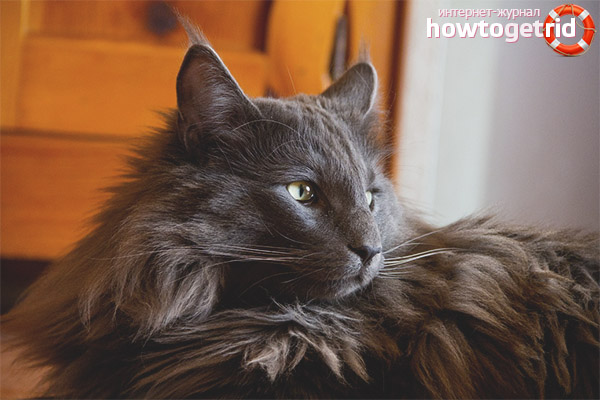The content of the article
Norwegian cat refers to the type of pets that can be both harsh or affectionate towards humans. The breed is distinguished by obstinate character, willpower, care for small children. Norwegian start as a family friend, and it is not surprising. Let's talk more about the main features of the "forest beast."
Historical summary
It is difficult to say for sure in which century the origin of Norwegians begins. However, experts say that around 1600s. The first mentions of cats can be found in the folk tales of the 1800s. In fairy tales it was mentioned about animals with long fluffy tails and expressive eyes.
In Norway, cats were extremely popular, but at some point they started to disappear altogether.The thing is crossing the Norwegian with pets of other breeds. Thus, the purebred representatives were decreasing with each passing month.
In order to prevent the disappearance of the species, a number of rules were introduced that affected the breeding and crossing of forest pets.
Before the breeder planned to breed cats, he had to appear before the committee and show his pets. If the committee approved the cats, registration was carried out with subsequent permission for breeding.
After many years, enthusiasts were able to resume the number of Norwegian cats, in the late 1970s, the breed was approved and could speak at exhibitions of European countries.
The breed has become famous throughout the world due to its impressive size and weight. Males can reach 9 kg., Females - a little less. At first you might think that such a furry beast should weigh a lot, but it is easy to understand inconsistencies in appearance if you look at the cat's undercoat. It is soft, thick, long, makes the animal massive.
External characteristics of the Norwegian cats
- Fans of this breed claim that the Norwegians are unique, unique.But to the unknowing person, the appearance of the pet will seem boring, nothing more than a non-purebred pet. This is partly true, but the breed has its own characteristics, which attract more and more attention to the Norwegians.
- Due to its forest origin, the animal is famous for its natural proportions, powerful chest, massive body, strong paws and neck.
- Despite its impressive size, this beast is a hunter by nature. The Norwegian cat is agile and fast, the body is slightly elongated, the hind legs are longer than the front ones, therefore the croup seems raised. This helps pets to sneak up on the prey and not leave it a chance.
- The paws of the Norwegians are large, they help to stand well and, if necessary, to make a sharp jerk. The belly is tucked up, the neck is massive and strong. In terms of their size, cats cannot be called gigantic, they are smaller than Siberian and Maine Coon.
- The almond-shaped eyes are expressive and clear, the cheekbones are high and clearly visible, the chin is prominent. The muzzle as a whole looks pretty and tidy, there are no abrupt transitions and unnaturalness in the build. Everything is as harmonious as possible.
- Fluffy thick fur (and the tail in particular) has a waterproof undercoat. In appearance you might think that the cat weighs a lot, but in fact it is not. Male's body weight hardly reaches 9 kg., Females weigh about 7.5 kg.
- According to external signs of the male from the female, it is possible to distinguish by the broad chest, eyes, powerful paws and confident gait. The female sex is more imposing, nicer. In the neck there is a "rim", like a lion, due to the long thick hair. The undercoat is waterproof, has a light oily structure at the base.
- As can be understood from all of the above, the “zest” of Norwegian lies in the fur of cats. On the paws are massive “pants”, the tail also boasts a lush woolen cover. Some pets have tassels on their ears, but their absence cannot be considered a defect.
- Due to the dense, not too soft wool, the Norwegian does not suffer from mats, there is no need to constantly comb it. This can not be said about cats with too soft fur coat, which is constantly whipped into the pellets.
- Since the breed is considered the main property of the wool, it pays special attention.To the fur coat has its own requirements and certain standards that the breed must meet.
- To choose a kitten, you need to look at the parents with a fully formed woolen cover. Because the younger generation is not yet endowed with special signs and can not meet the criteria.
Norwegian cats color varieties
- There are quite a few varieties of animal coat color. Starting from smoky gray and deep black, ending with brown with reddish patches, white, reddish, with stripes or marble color.
- According to some data, the color of forest beauties is so diverse, because the cat lived in places with an impressive natural landscape. Some of the cats come from the central part, others lived in the south, etc.
- Since, by their nature, Norwegian hunters, they tried to get as close as possible to their surroundings. This is just a rumor, in fact - the wool color is less, the more expensive pet.
- It has already been described that great demands are made on the quality of wool. The same can be said about her color.If the shade is solid, there should not be any other inclusions, for example, at the base of the coat or at the edges of the fur.
- If the pet is striped, it should not have a washed-out pattern. All patterns in high-quality representatives of the breed are clear, well distinguishable, one color does not flow into another imperceptibly. It is difficult not to notice the obvious separation of borders, and it is worth relying on this when choosing.
- Well, if the shade of the coat will be close to the color of the eyes. Breed standards do not allow hints of other breeds, for example, Maine Coon, Siamese cats, etc., to be present in the coloring.
Breed character
- Most owners say that a real forest cat lives in their homes. Unfortunately, this is not the case. From the wild breed only the name remains. The Norwegian cat is quite friendly and calm. Wildness in such a pet can appear just as much as in a regular cat. The breed in question is very affectionate and loves attention.
- If you get a kitten, be prepared for increased activity and curiosity of the animal. Norwegian cats can play from morning to evening.Kittens are very fond of people and can not be ignored. Therefore, you just have to constantly stroke and caress a new pet. Such cats love children and play with them with pleasure.
- When a pet matures, its activity subsides somewhat. But do not think that the cat will only decorate your sofa and constantly sleep. The Norwegian breed will constantly monitor everyone and “keep order”. Adult cats are quite active, so if you want to play with him, there will be no problems.
- This breed is considered to be one of the most intelligent, so it will not be difficult to accustom the cat to the tray. Also, the pet is trainable. Even two-month-old kittens will already know where to go to the toilet. If you put a scraper, torn furniture you will not see. It is enough to devote a little time to education. Cats are clever and clean, so they will not be in trouble.
Care and maintenance
- It is necessary to take into account all the features and disadvantages of the breed. Such cats have excellent sustainable psyche. Thanks to this feature, the pet can get along with any family and company. The animal is not shy and very patient.The cat will leave the room rather than aggressively respond.
- Norwegian cats are excellent to strangers and loyal to little annoying children. Such pets easily get along with the dogs and are quite friendly with the rest of the animals. It is worth noting that if you first brought a cat, and then a rodent or a bird, you should not leave them alone. Still, the Norwegian cat - a hunter from nature.
- As for the content, the breed in question is not picky and does not require more than an ordinary cat. It is enough to provide the animal with a small cozy corner, toys, and ideally a special climbing barrel. If you live in a private house, you can safely leave the animal for a walk. Such cats are loyal and know their home.
- Such an animal, even no one wants to steal, because the Norwegian cat is almost no different from the usual (no offense to the owners). The breed is almost picky, the only thing that kittens need to be taught to systematically clean the ears, grooming claws and combing wool. As a result, adult cats will tolerate such procedures without problems.
- As mentioned earlier, pets have a very thick and fluffy coat.Therefore, start to accustom the animal from an early age to combing wool. The cat should just have fun. Perform the procedure 2 times a week. As a result, the coat will look perfect. Use a special brush without droplets on the ends of the teeth. Otherwise, the fur will be pulled out.
- To lay the wool easily, it is recommended to use the usual metal comb with frequent teeth. Pre-treat the comb with a special antistatic agent. Bathing should be done in rare cases or if the cat got dirty in some way. The rest of the animal cleanliness and lick itself.
- As for food, you will not encounter anything special. You do not have to buy special delicacies. The only thing that should be noted, quality food has not been canceled. A balanced diet will guarantee a high life expectancy and excellent cat health. For details check with the breeders.
Diseases and breed health
- Often, purebred pedigree animals may have hygiene problems. Do not worry ahead of time, the Norwegian cat is not affected.Such animals are considered healthy and virtually trouble free.
- In rare cases, glycogenosis can be inherited by a pet. This pathology has a negative effect on the digestion of glucose in animals. The disease may not occur until 6 months. Such cats soon die and, unfortunately, do nothing with it.
In general, the Norwegian cat is not picky and quite beautiful. When choosing a kitten, rely solely on the quality of wool. If possible, look at the pedigree. A pedigreed kitten is very difficult to distinguish from a yard. Therefore, you need to have some knowledge of the breed. Also it is worth trying to find proven breeders.
Video: Norwegian Forest Cat













To send